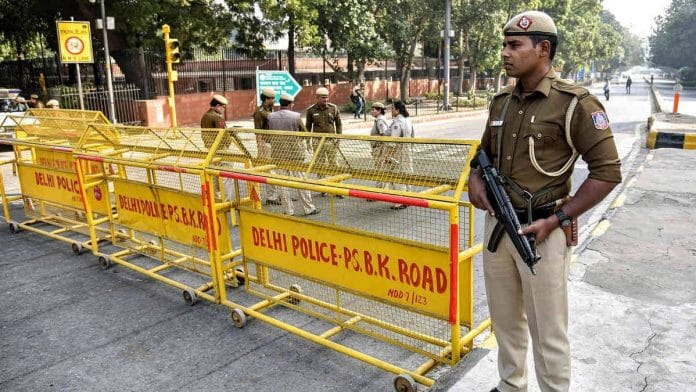New Delhi: India has one judge for every 50,000 citizens, while each police person is responsible for the safety of 858 people, the India Justice Report 2020 released Thursday has found.
The report is an initiative of Tata Trusts in collaboration with Centre for Social Justice, Common Cause, Commonwealth Human Rights Initiative, DAKSH, TISS-Prayas, Vidhi Centre for Legal Policy, and How India Lives.
The first India Justice Report was published in November 2019, and ranks states on four pillars — judiciary, police, prisons and legal aid. It is based on the latest available government figures, as well as “quantitative measurements of budgets, human resources, infrastructure, workload, diversity across police, judiciary, prisons and legal aid in 18 large and medium-sized states with a population of over 1 crore and 7 small states”.
Uttar Pradesh finished at the bottom of the rankings among the large and mid-sized states in terms of overall delivery of justice, with a score of 3.15 out of 10, while Maharashtra was at the top, with a score of 5.77 out of 10. Tamil Nadu and Telangana were second and third-best. Among the seven small states, Tripura topped the list, while Meghalaya came in last.
Also read: 4 pleas, 15 dates and an interim order — electoral bond case hangs fire in SC for over 3 yrs
State of judiciary and law enforcement
The report said the ratio of police personnel to common citizens has actually ballooned by 75 — to 858 in 2018-19 from 783 in 2017.
“Illustratively, (India’s) BRICS partners, Russia and South Africa, with far smaller populations, have better ratios,” it said.
“Averages also hide worse realities and stark contrasts between states. Bihar, for instance, has one police person for 1,548 persons. This is, however, a reduction by 115 persons from three years ago; West Bengal has one for every 1,284; and Assam one for every 1,243. Punjab, at one for nearly 462 persons has the lowest ratio amongst large and mid-sized states. Manipur, under the Armed Forces Special Powers Act (AFSPA), has one police person for every 202,” the report states.
The India Justice Report also pointed out that nationally, the average number of cases pending in high courts rose to 44.25 lakh in 2018-19 from about 40.12 lakh in 2016-17, while in lower courts, the corresponding figures were 2.97 crore and 2.83 crore.
The report also noted a 14 per cent shortage of court halls. But it also indicated a positive trend in filling judicial vacancies.
“In 2016-17, average high court judge vacancies were at 42 per cent, subordinate courts at 23 per cent, and only four states and two UTs had sufficient courtrooms. Nationally, as of 2018-19, vacancies have come down to 38 per cent in the high courts and 22 per cent in the subordinate courts,” it said.
On diversity within the judiciary, the report said: “On average, the share of women judges in the high courts increased marginally from 11 per cent to 13 per cent, while in subordinate courts, it increased from 28 per cent to 30 per cent… This means that while one in three judges in the subordinate courts is a woman, in the high courts, only one in nine judges is a woman.”
“The glass ceiling remains intact,” it added.
The national average for women in police forces is 10 per cent, and Karnataka is the only state to fully meet its SC, ST and OBC quotas for police officers. SC, ST and OBC quotas are set in proportion to their populations and applied in entry-level direct recruitment, the report explained.
State of prisons
Another section in the report titled ‘Prisons: Reforms barred?’ found that “two-thirds of the total prisoners in India are imprisoned without conviction”. It also found overcrowding in prisons at 19 per cent, saying: “Unnecessary arrests, conservative approaches to granting bail, uncertain access to legal aid, delays at trial, as well as the inefficacy of monitoring mechanisms such as Under Trial Review Committees continue to contribute to overcrowding.”
The report pointed out that the Model Prison Manual, 2016, sets the standard at one correctional officer for every 200 prisoners and one psychologist/counsellor for every 500. However, it noted that only Jammu and Kashmir (194), Bihar (167), and Odisha (123) meet this benchmark.
“While both meet their sanctioned numbers, Uttar Pradesh, despite a prison population of over 100,000, has sanctioned only two correctional officer posts; Jharkhand, with a far lower population of 18,654 inmates, has four,” it added.
An additional backgrounder on the report said the number of deaths per 1 lakh prisoners in 2019 was 370.87. “The prevalence of HIV, sexually transmitted infections, Hepatitis B and C, and tuberculosis in prison populations is two to 10 times higher than the general population,” it said.
On legal aid, the report said while almost 80 per cent of India’s over 1.3 billion population is eligible for free legal aid, only 1.5 crore people have received free legal aid in the last 25 years.
Also read: CAA case comes up just thrice in 1 year in SC despite 140 pleas, including from UN body






